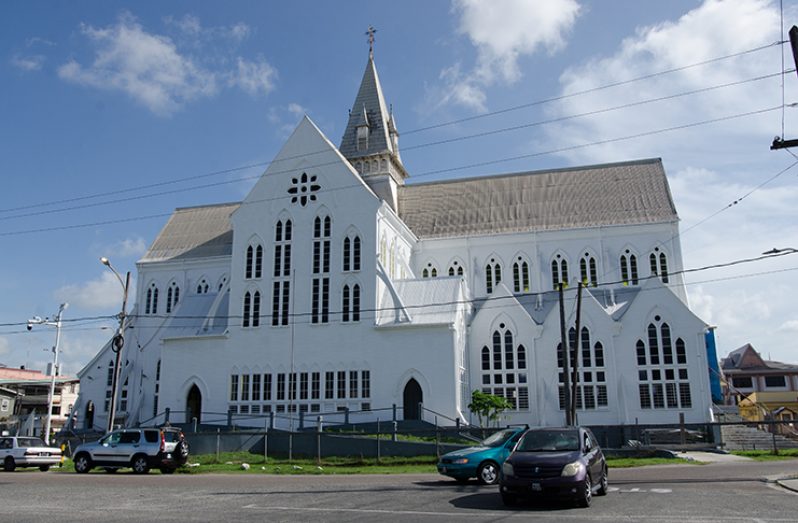A true Guyanese relic
By Jared Liddell
STANDING majestically at the centre of Church Street and North Road is one of the most famous Guyanese architectural wonders — the St George’s Cathedral. The building, which is known as ‘the tallest wooden building in the western hemisphere,’ stands at a towering 143 feet. It is not just world famous for its height, but also for the immense amount of detailing that went into not only the exterior but also the interior of the building.

From the hand-carved mouldings to the majestic, stained glass windows, Gothic arches, clustered columns, flying buttresses, arched ceiling and built-in musical organs with musical pipes, the cathedral is not just a sight to behold; it is also a national treasure. The cathedral was built in 1889 and stands some 177 years, with almost all of its original architecture intact.
In 2017, the leadership of the cathedral decided that the church was overdue for repairs, but they didn’t wish to modernise the structure. They had a vision of preserving the history it, so they embarked on the St George’s Cathedral Restoration Plan.
The plan was devised between the leadership of the church and the National Trust of Guyana. The purpose for the restoration was to ensure that as much thought as went into the initial design of the building, be brought back today, to ensure that every detail is restored as, and redone exactly the same as before.
In an interview with the present Bishop of the cathedral, Bishop Charles Davidson, he posited that the commissioning of the cathedral has an extremely rich history with the emergence of the city of Georgetown, but that many persons are not aware of the true significance of the St George’s Cathedral.
“The history of the cathedral is pretty close to the history of the city. In colonial days, when the British ruled Guyana, it was said that cities will only come into being after cathedrals are built. The city of Georgetown is 176 years old, and the St George’s Cathedral is 177 years old. That seems to be true.
In 1842, when Percy Austin became Bishop of the Anglican Church, he consecrated the building and named it the St George’s Cathedral after King George of course, and consequently, the city became known as Georgetown,” said Davidson.
He went on to state that the decision to keep the church’s initial design and detailing was not just a decision made by himself and the other leaders of the church, but also by the National Trust of Guyana. He explained that buildings which are national treasures come under the Guyana National Trust, and as such, they are protected as monuments; therefore, no structural changes can be made without the express approval of this body.
“Once the National Trust says that your building is a national building you have to get permission from them to change it. This is a National Trust building and if you see the pictures from years gone by, you’ll recognise that things have been changed on the building. You can’t change the inside, but you are able to make minor changes to the outside. The National Trust wants to be able to say to the world that this is the original building that existed in 1889, and we haven’t changed anything on the inside; you can change on the outside but not on the inside.”
Davidson stated that some work was started on the building, but that came to a standstill as the church had run out of funds to complete the project. He stated that they were able to complete the northern wall of the church, but that single change cost the church over $38 million. The Bishop stated that the total cost for the entire restoration process would be somewhere around 175 m.
“We finished the north wall which is furnished with a new ramp and all that kind of stuff; the west wall I think is almost finished and we ran out of money, so we stopped the work nearly seven months ago. What we have to do now is complete the west wall and south wall, maybe half of the south wall has been constructed, but it needs to be completed. So basically that’s what we are doing at this point.
When asked if the National Trust of Guyana had contributed to the renovation, Bishop Charles remarked, “So because it was a national shrine, the government during 2017 and 2018 gave us about $22 million to help us to do the work. Outside of that, the church has financed the whole project. So far, the church would be spending like $175 million to do the four walls. We have to go back and look at the west wall and do some work on that. When that’s done, we would have to do the main roof, but we do not yet have an estimate for that.”
The bishop further stated that donations from members of the church were able to cover some $12 million of the cost in Phase One of the restoration. Davison told the Pepperpot Magazine that cathedrals are known historically to be largely expensive buildings to restore, due to having to find experts in the field of carpentry, as well as the cost it would be to replace the wood (in this case greenheart), stained glass windows, and every other tiny detail that went into the initial building.
Bishop Davidson went on to explain that although the church has received donations from prominent Guyanese businesses such as Banks DIH and all of the paint used thus far, the renovation is still far from over. He said that he would welcome other members of society’s contributions to be able to complete in a timely manner, the work on this historic landmark of which all Guyanese are extremely proud.




.jpg)












